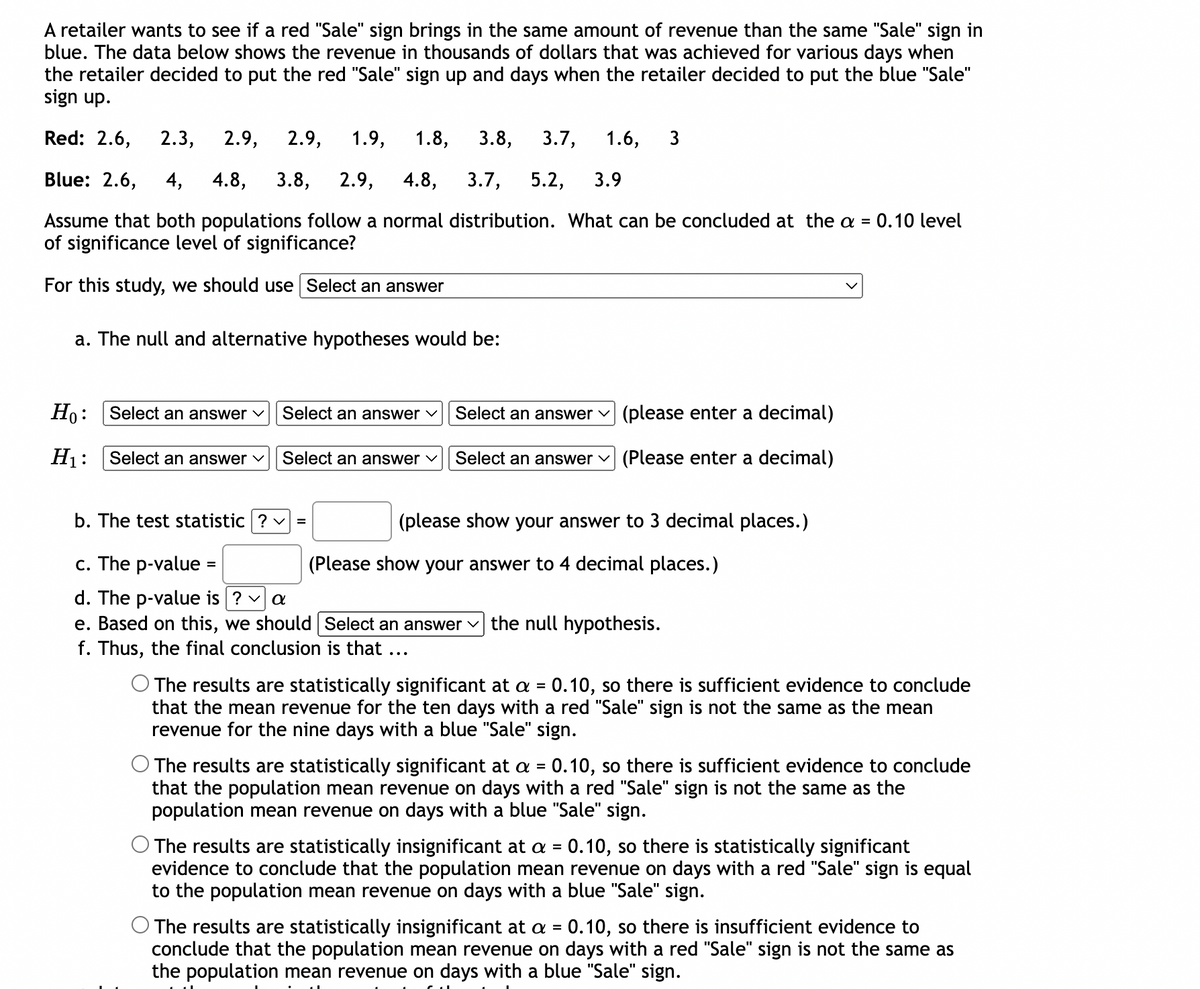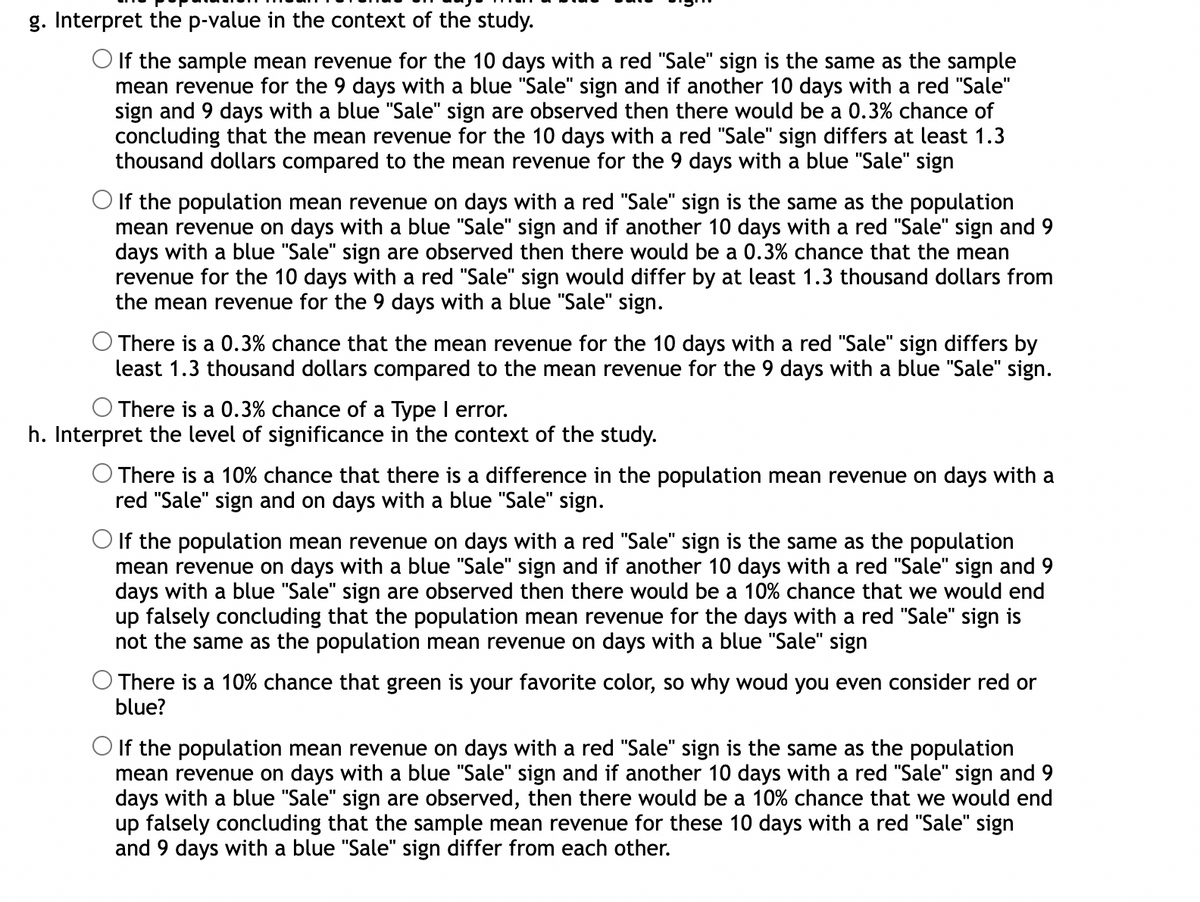A retailer wants to see if a red "Sale" sign brings in the same amount of revenue than the same "Sale" sign in blue. The data below shows the revenue in thousands of dollars that was achieved for various days when the retailer decided to put the red "Sale" sign up and days when the retailer decided to put the blue "Sale" sign up. Red: 2.6, 2.3, 2.9, 2.9, 1.9, 1.8, 3.8, 3.7, 1.6, 3 Blue: 2.6, 4, 4.8, 3.8, 2.9, 4.8, 3.7, 5.2, 3.9 Assume that both populations follow a normal distribution. What can be concluded at the a = 0.10 level of significance level of significance? For this study, we should use Select an answer a The pull and alternative hypotheses would be:
A retailer wants to see if a red "Sale" sign brings in the same amount of revenue than the same "Sale" sign in blue. The data below shows the revenue in thousands of dollars that was achieved for various days when the retailer decided to put the red "Sale" sign up and days when the retailer decided to put the blue "Sale" sign up. Red: 2.6, 2.3, 2.9, 2.9, 1.9, 1.8, 3.8, 3.7, 1.6, 3 Blue: 2.6, 4, 4.8, 3.8, 2.9, 4.8, 3.7, 5.2, 3.9 Assume that both populations follow a normal distribution. What can be concluded at the a = 0.10 level of significance level of significance? For this study, we should use Select an answer a The pull and alternative hypotheses would be:
Glencoe Algebra 1, Student Edition, 9780079039897, 0079039898, 2018
18th Edition
ISBN:9780079039897
Author:Carter
Publisher:Carter
Chapter10: Statistics
Section10.5: Comparing Sets Of Data
Problem 26PFA
Related questions
Question

Transcribed Image Text:A retailer wants to see if a red "Sale" sign brings in the same amount of revenue than the same "Sale" sign in
blue. The data below shows the revenue in thousands of dollars that was achieved for various days when
the retailer decided to put the red "Sale" sign up and days when the retailer decided to put the blue "Sale"
sign up.
Red: 2.6, 2.3, 2.9, 2.9, 1.9, 1.8, 3.8,
3.7, 1.6, 3
Blue: 2.6, 4, 4.8, 3.8, 2.9, 4.8, 3.7, 5.2, 3.9
Assume that both populations follow a normal distribution. What can be concluded at the a = 0.10 level
of significance level of significance?
For this study, we should use Select an answer
a. The null and alternative hypotheses would be:
Ho: Select an answer
H₁:
Select an answer ✓
Select an answer ✓
Select an answer ✓
Select an answer ✓
(please enter a decimal)
Select an answer (Please enter a decimal)
b. The test statistic ? ✓ =
c. The p-value =
d. The p-value is ? ✓ a
e. Based on this, we should | Select an answer the null hypothesis.
f. Thus, the final conclusion is that ...
(please show your answer to 3 decimal places.)
(Please show your answer to 4 decimal places.)
The results are statistically significant at a = 0.10, so there is sufficient evidence to conclude
that the mean revenue for the ten days with a red "Sale" sign is not the same as the mean
revenue for the nine days with a blue "Sale" sign.
The results are statistically significant at a = 0.10, so there is sufficient evidence to conclude
that the population mean revenue on days with a red "Sale" sign is not the same as the
population mean revenue on days with a blue "Sale" sign.
O The results are statistically insignificant at a = 0.10, so there is statistically significant
evidence to conclude that the population mean revenue on days with a red "Sale" sign is equal
to the population mean revenue on days with a blue "Sale" sign.
O The results are statistically insignificant at a = 0.10, so there is insufficient evidence to
conclude that the population mean revenue on days with a red "Sale" sign is not the same as
the population mean revenue on days with a blue "Sale" sign.

Transcribed Image Text:g. Interpret the p-value in the context of the study.
O If the sample mean revenue for the 10 days with a red "Sale" sign is the same as the sample
mean revenue for the 9 days with a blue "Sale" sign and if another 10 days with a red "Sale"
sign and 9 days with a blue "Sale" sign are observed then there would be a 0.3% chance of
concluding that the mean revenue for the 10 days with a red "Sale" sign differs at least 1.3
thousand dollars compared to the mean revenue for the 9 days with a blue "Sale" sign
O If the population mean revenue on days with a red "Sale" sign is the same as the population
mean revenue on days with a blue "Sale" sign and if another 10 days with a red "Sale" sign and 9
days with a blue "Sale" sign are observed then there would be a 0.3% chance that the mean
revenue for the 10 days with a red "Sale" sign would differ by at least 1.3 thousand dollars from
the mean revenue for the 9 days with a blue "Sale" sign.
There is a 0.3% chance that the mean revenue for the 10 days with a red "Sale" sign differs by
least 1.3 thousand dollars compared to the mean revenue for the 9 days with a blue "Sale" sign.
O There is a 0.3% chance of a Type I error.
h. Interpret the level of significance in the context of the study.
There is a 10% chance that there is a difference in the population mean revenue on days with a
red "Sale" sign and on days with a blue "Sale" sign.
O If the population mean revenue on days with a red "Sale" sign is the same as the population
mean revenue on days with a blue "Sale" sign and if another 10 days with a red "Sale" sign and 9
days with a blue "Sale" sign are observed then there would be a 10% chance that we would end
up falsely concluding that the population mean revenue for the days with a red "Sale" sign is
not the same as the population mean revenue on days with a blue "Sale" sign
O There is a 10% chance that green is your favorite color, so why woud you even consider red or
blue?
O If the population mean revenue on days with a red "Sale" sign is the same as the population
mean revenue on days with a blue "Sale" sign and if another 10 days with a red "Sale" sign and 9
days with a blue "Sale" sign are observed, then there would be a 10% chance that we would end
up falsely concluding that the sample mean revenue for these 10 days with a red "Sale" sign
and 9 days with a blue "Sale" sign differ from each other.
Expert Solution
This question has been solved!
Explore an expertly crafted, step-by-step solution for a thorough understanding of key concepts.
Step by step
Solved in 8 steps with 5 images

Recommended textbooks for you

Glencoe Algebra 1, Student Edition, 9780079039897…
Algebra
ISBN:
9780079039897
Author:
Carter
Publisher:
McGraw Hill

Big Ideas Math A Bridge To Success Algebra 1: Stu…
Algebra
ISBN:
9781680331141
Author:
HOUGHTON MIFFLIN HARCOURT
Publisher:
Houghton Mifflin Harcourt

Holt Mcdougal Larson Pre-algebra: Student Edition…
Algebra
ISBN:
9780547587776
Author:
HOLT MCDOUGAL
Publisher:
HOLT MCDOUGAL

Glencoe Algebra 1, Student Edition, 9780079039897…
Algebra
ISBN:
9780079039897
Author:
Carter
Publisher:
McGraw Hill

Big Ideas Math A Bridge To Success Algebra 1: Stu…
Algebra
ISBN:
9781680331141
Author:
HOUGHTON MIFFLIN HARCOURT
Publisher:
Houghton Mifflin Harcourt

Holt Mcdougal Larson Pre-algebra: Student Edition…
Algebra
ISBN:
9780547587776
Author:
HOLT MCDOUGAL
Publisher:
HOLT MCDOUGAL

Functions and Change: A Modeling Approach to Coll…
Algebra
ISBN:
9781337111348
Author:
Bruce Crauder, Benny Evans, Alan Noell
Publisher:
Cengage Learning

Mathematics For Machine Technology
Advanced Math
ISBN:
9781337798310
Author:
Peterson, John.
Publisher:
Cengage Learning,